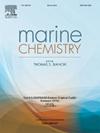Copper-binding organic ligands and phytoplankton growth in Japanese coastal waters
IF 2.5
3区 地球科学
Q2 CHEMISTRY, MULTIDISCIPLINARY
引用次数: 0
Abstract
Although copper (Cu) is necessary for phytoplankton growth, it becomes toxic at high concentrations. The bioavailability and toxicity of Cu are governed by its chemical speciation, with free inorganic Cu2+ being the most toxic species. In this study, we estimated free Cu2+ concentrations in Japanese coastal waters to evaluate the effects of Cu toxicity on phytoplankton growth. Incubation experiments were conducted using natural phytoplankton assemblages in seawater collected from Otsuchi Bay, northeastern Japan, and Goto-nada in the East China Sea. The cells were incubated for 14 days with Cu additions of up to 100 nM. Copper speciation parameters were determined using the reverse titration methods with competitive ligand exchange adsorptive cathodic stripping voltammetry (CLE-AdCSV). Chlorophyll-a concentrations increased with the addition of <10 nM Cu but decreased at 100 nM Cu due to Cu toxicity. We found that phytoplankton growth caused negligible increases in Cu-binding organic ligand concentrations. Free Cu2+ concentrations were simulated using the initial Cu speciation parameters obtained from the reverse titration method under varying Cu concentrations. When assuming the presence of only one class of organic ligands, the estimated Cu2+ concentrations were inconsistent with the incubation results. In contrast, by considering two classes of ligands, the increase in the concentration of Cu2+ closely matched the incubation data. This suggests that the resolution of the weaker class of organic ligands is crucial for evaluating Cu toxicity in seawater.

日本沿海水域铜结合有机配体与浮游植物生长
虽然铜(Cu)是浮游植物生长所必需的,但它在高浓度时会产生毒性。Cu的生物利用度和毒性受其化学形态的支配,其中游离无机Cu2+是毒性最大的形态。在本研究中,我们估算了日本沿海水域的游离Cu2+浓度,以评估Cu毒性对浮游植物生长的影响。利用日本东北部大池湾和东海后户那田海域采集的天然浮游植物组合进行了培养实验。细胞在添加浓度为100 nM的Cu的条件下孵育14天。采用竞争配体交换吸附阴极溶出伏安法(cl - adcsv)反滴定法测定铜的形态参数。叶绿素-a浓度随着添加10 nM Cu而增加,但在添加100 nM Cu时,由于Cu的毒性,叶绿素-a浓度下降。我们发现浮游植物的生长对铜结合有机配体浓度的增加可以忽略不计。利用反滴定法获得的初始Cu形态参数,模拟了不同Cu浓度下的游离Cu2+浓度。当假设只有一类有机配体存在时,估计的Cu2+浓度与孵育结果不一致。相比之下,考虑两类配体时,Cu2+浓度的增加与孵育数据非常吻合。这表明弱类有机配体的分辨是评价海水中铜毒性的关键。
本文章由计算机程序翻译,如有差异,请以英文原文为准。
求助全文
约1分钟内获得全文
求助全文
来源期刊

Marine Chemistry
化学-海洋学
CiteScore
6.00
自引率
3.30%
发文量
70
审稿时长
4.5 months
期刊介绍:
Marine Chemistry is an international medium for the publication of original studies and occasional reviews in the field of chemistry in the marine environment, with emphasis on the dynamic approach. The journal endeavours to cover all aspects, from chemical processes to theoretical and experimental work, and, by providing a central channel of communication, to speed the flow of information in this relatively new and rapidly expanding discipline.
 求助内容:
求助内容: 应助结果提醒方式:
应助结果提醒方式:


